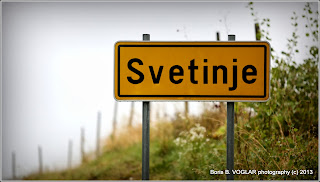Thursday, 12th of September 2013
The grand
plan went on. We started the day by dividing into two groups, the first one
containing the fast and enduring, while the second group consisted of the
precise and well-equipped. The first group’s task of the day included 40
kilometres of cycling and 820 metres of altitude difference. Note that in all
the previous days combined, we cycled for 80 kilometres and beat 800 metres of
altitude. Brave people.
The second
group walked to Svetinje, proliferated with maps, cameras and coloured markers.
They mapped out areas in need of reparation or with a potential to support new
infrastructure for hikers and bikers.
The Marathoners
The
Marathoners (alias 3 Shades of Blue, due to our matching outfits) launched out
at 9’o clock and headed towards Ljutomer via Gresovščak and those lovely
fishing ponds mentioned before in the blog. Oh, remember the third area of
interest, mentioned in our first blog post? The one about wider areas meant for
(semi) professionals? We were covering that part today. We drove through
Slamnjak, Ilovci, Hermanci and then rushed downhill to Miklavž pri Ormožu.
The
route continued along the valley and the main road between Miklavž and Ormož. Next
we turned towards Hum pri Ormožu. While pedalling uphill we noticed a marked
hiking route, which led us to the church atop Hum. Local Rumour has it, that
there is a hiker’s stamp hidden somewhere around the now defunct school
building. Hum had a kind of mysterious
charm to it. We suspect that has something to do with the locals, who kindly
offered us figs and the best wine in Slovenia (according to a competition by
the newspaper Delo). All shades of blue unanimously agreed that Hum deserves a
place on the longer route.
After the
Hum experience we headed towards Ormož. Disregarding the road maintenance
services in Pušenci, we turned from the main road and found a separate cycling
track, which brought us to Ormož safely. From there, we drove on a tranquil
road through Dobrava, Limerk and Stanovno.
As we reached the top of the ridge,
we had our breath taken by the far-reaching view. Remembering to breathe again,
we darted downhill to Ivanjkovci, crossed the main road and pedalled towards
Veličane. The sky cleared at last and light swept through the valleys. The
planned visit to Cerovedc Stanka Vraza had to be cancelled, as the hospitable
Hum took too much time. Instead we headed uphill towards Taverna (the stylish
tavern you should visit when around). There we took a few moments to rest and
enjoy our first dose of sunlight in days. Twenty minutes later we arrived at
Vinski Hram Jeruzalem and met up with the second group.
The Designers
The second
groups, dubbed the designers, took a walk to Svetinje. Though exploring a
familiar route, there was more than enough motivation to find new solutions.
The first major thing that caught our attention was the layer of gravel on a
steep downward slope road, right before a sharp turn. A storm two days before
ravaged the gravel embankments and the road was turned into a killing ground
for the unwary. When we later headed back past the same spot, the gravel was
removed from the road, but put back into the embankment. It’ll stay there until
the next storm.
We also
inspected the area for spots and stripes suitable for new infrastructure. We
figured there are two basic ways to provide security for bikers. The narrow
roads could either be extended, giving more space for both cars and bikes, or
separate parallel tracks could be made, to keep cyclists out of car’s way. We
found the idea of separated tracks quite appealing, since it would be possible
to direct the tracks trough parts of the vineyards, opening up many unique
viewpoints, otherwise unavailable from the current main road.
Our third
task was to mark potential rest areas. This task was quite difficult, since the
entire area is scenic enough to serve as a rest area, but we managed.
All
suggestions were drawn into a map and photos of interesting places were taken.
After the reconnaissance we met up with the Marathoners in Jeruzalem.
Hectic afternoon
As usually,
we exchanged impressions and terrain intelligence. The sun was shining outside,
but unfortunately we couldn’t bask in it much. It was once again time to
review, edit, rephrase and analyse all the data and experiences we gathered in
the past few days. Expect our results shortly and make sure you tune in later
for more reports.
































